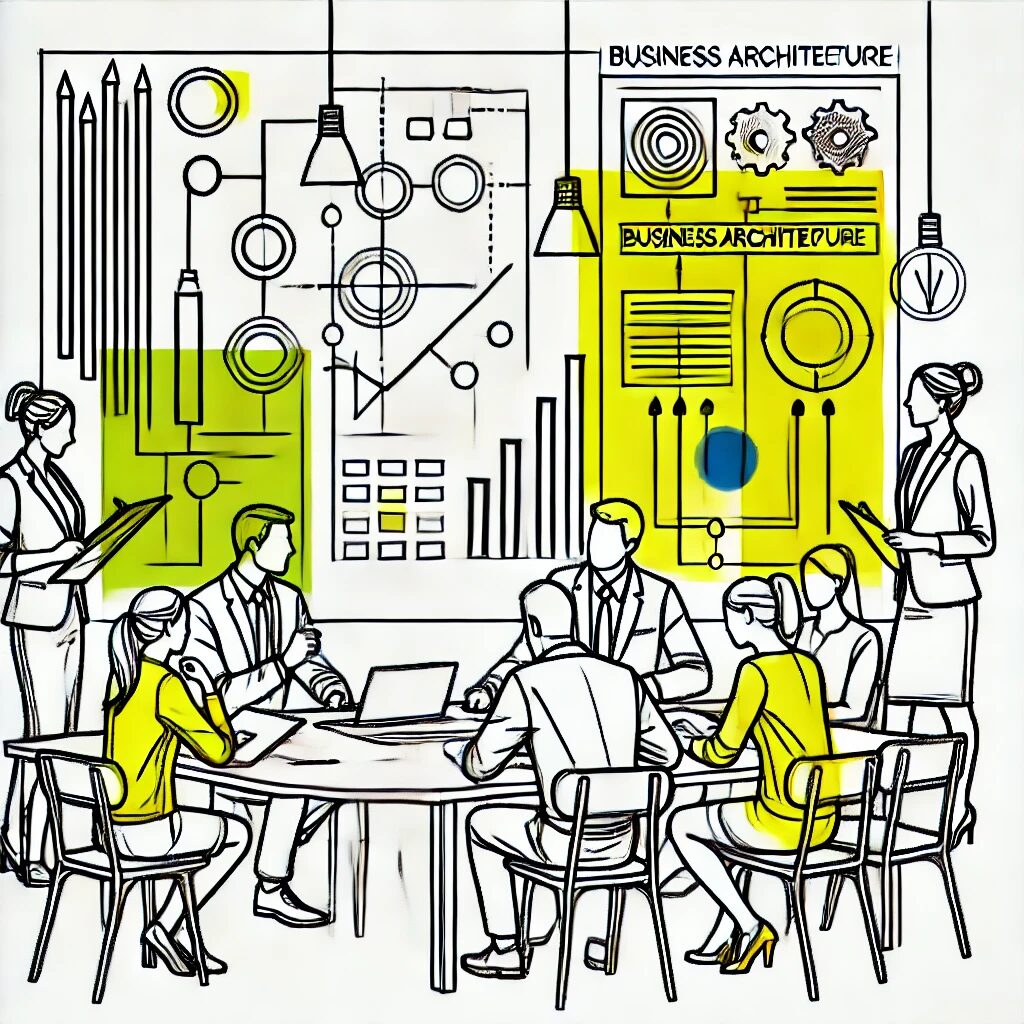
Business Architecture as the GPS for Transportation Transformation. From Routes to Remarkable: How Business Architecture Steers Transportation Enterprises to Their Future State.
In today’s rapidly evolving transportation landscape, companies face unprecedented disruption from autonomous vehicles, mobility-as-a-service platforms, sustainability mandates, and changing consumer expectations. These forces demand not just incremental improvements but comprehensive enterprise transformation.
Business Architecture is the essential navigation system for this journey, connecting strategic vision to operational reality and providing the blueprint that aligns people, processes, and technology. For transportation enterprises seeking to thrive amid industry upheaval, Business Architecture isn’t just a framework—it’s the vehicle that drives sustainable transformation.
1: The Transformation Imperative in Transportation
Transportation companies today face a perfect storm of disruptive forces. The sector has been experiencing more change in the past decade than it saw in the previous century, demanding the evolution of the fundamental business model.
- Market Volatility: Transportation markets experience increasing unpredictability due to fuel price fluctuations, geopolitical tensions, and supply chain disruptions, requiring adaptive business models.
- Digital Disruption: New entrants with platform-based business models are redefining customer expectations and threatening traditional transportation value chains.
- Sustainability Pressures: Regulatory requirements and consumer demand for greener transportation options are forcing companies to rethink their environmental footprint and operational approach.
- Workforce Transformation: The growing technology component of transportation requires new skills and organizational structures to support innovation and digital capabilities.
- Infrastructure Evolution: Smart infrastructure and connected transportation networks demand new partnership models and integration capabilities from transportation providers.
2: Business Architecture as Your Transformation Compass
Business Architecture provides the essential connective tissue between strategic intent and operational execution. It ensures transformation efforts remain aligned with business outcomes.
- Strategic Alignment: Business Architecture translates corporate vision into practical capabilities, ensuring every transformation initiative directly supports strategic objectives.
- Complexity Management: The discipline helps transportation companies visualize and navigate their complex operational landscapes, identifying redundancies and integration points.
- Change Coordination: By mapping interdependencies between business functions, technology, and processes, Business Architecture enables synchronized change across the enterprise.
- Capability Prioritization: The framework provides objective methods for evaluating which capabilities require investment to support the transformation agenda.
- Outcome Orientation: Business Architecture keeps transformation focused on measurable business outcomes rather than just implementing new technologies or processes.
3: Mapping the Transportation Value Chain
A comprehensive understanding of your transportation value chain is fundamental to transformation. Business Architecture creates this foundation through detailed capability mapping.
- Core Operations Mapping: Detailed mapping of fleet management, routing, scheduling, and logistics capabilities reveals optimization opportunities and technology enablement needs.
- Customer Experience Design: Business Architecture connects customer journey maps to operational capabilities, identifying gaps in meeting evolving customer expectations.
- Partner Ecosystem Integration: Modern transportation requires complex partner networks—Business Architecture helps define integration points and data flows across ecosystem boundaries.
- Regulatory Compliance Framework: Transportation-specific regulatory requirements become integrated elements of the architecture, ensuring compliance by design.
- Service Delivery Model: Business Architecture helps transportation companies evolve from asset-focused to service-oriented business models by identifying necessary new capabilities.
DID YOU KNOW?
- According to McKinsey’s research, transportation companies with mature business architecture practices are 2.3 times more likely to successfully execute complex transformation initiatives than those without established architectural capabilities.
4: Building Your Transportation Capability Map
The capability map serves as the cornerstone of Business Architecture, providing a shared understanding of what the transportation enterprise does and how it creates value.
- Modal Operations: Transportation companies must map capabilities specific to their modes (air, rail, road, sea) while identifying opportunities for cross-modal integration and efficiency.
- Asset Management: Comprehensive mapping of fleet acquisition, maintenance, utilization, and retirement capabilities enables optimization of capital-intensive transportation assets.
- Network Optimization: Business Architecture helps identify capabilities needed for continuous network evaluation and adjustment based on demand patterns and service requirements.
- Safety and Risk Management: Transportation-specific risk capabilities must be embedded throughout the architecture to protect passengers, cargo, employees, and communities.
- Sustainability Enablement: New capabilities supporting emissions tracking, alternative fuel adoption, and environmental reporting must be integrated into the transportation architecture.
5: From Roadmap to Reality – Transformation Planning
Business Architecture translates strategic intent into actionable transformation initiatives with clear sequencing and dependencies.
- Capability Gap Analysis: Business Architecture identifies the delta between current and required future-state capabilities to support new transportation business models.
- Initiative Portfolio Development: The framework helps create a balanced transformation portfolio that delivers both quick wins and long-term strategic advantage.
- Technology Enablement Mapping: Business Architecture connects business capabilities to their enabling technologies, ensuring IT investments directly support business outcomes.
- Transformation Sequencing: By understanding capability dependencies, Business Architecture determines the optimal sequence for implementing transformation initiatives.
- Investment Prioritization: The discipline provides objective criteria for allocating transformation resources based on strategic importance, value delivery, and implementation complexity.
6: Aligning Organization and Operating Model
Transportation transformation requires evolution of organizational structures and operating models to support new business capabilities and customer propositions.
- Organizational Design Alignment: Business Architecture helps transportation companies restructure around capabilities rather than legacy functional silos to increase agility.
- Role and Responsibility Redesign: The framework clarifies how roles must evolve to support new digital and customer-centric transportation services.
- Governance Modernization: Business Architecture helps establish governance mechanisms that balance innovation with the safety and reliability requirements of transportation operations.
- Process Ownership Framework: Clear process ownership across the transportation value chain ensures accountability for performance and continuous improvement.
- Decision Rights Allocation: The discipline helps define where and how decisions should be made in the transformed organization for optimal speed and quality.
7: Technology Architecture for Connected Transportation
Business Architecture provides the foundation for aligning technology architecture with the unique requirements of modern transportation enterprises.
- Digital Platform Strategy: Business Architecture helps transportation companies design platform-based technology architectures that support ecosystem integration and new service models.
- Data Architecture Alignment: The framework ensures data architecture supports real-time operations, predictive maintenance, and advanced analytics needs specific to transportation.
- Legacy Modernization Roadmap: Business Architecture prioritizes which legacy systems to modernize based on their impact on critical transportation business capabilities.
- IoT and Telematics Integration: The discipline helps design architectural components that capture and leverage the growing flood of vehicle and infrastructure sensor data.
- Mobility Service Enablement: Business Architecture identifies the technological components needed to support modern mobility services beyond traditional transportation models.
8: Customer Experience Transformation
Business Architecture connects customer experience design with operational capabilities to ensure transportation companies can deliver on their customer promises.
- Journey-to-Capability Mapping: Business Architecture maps customer journeys to specific business capabilities, identifying gaps in the ability to deliver desired experiences.
- Channel Integration Design: The framework helps transportation companies design seamless omnichannel experiences across digital and physical touchpoints.
- Personalization Enablement: Business Architecture identifies the capabilities and data required to deliver personalized transportation experiences at scale.
- Self-Service Architecture: The discipline helps design self-service capabilities that empower customers while optimizing operational efficiency.
- Experience Measurement Framework: Business Architecture connects experience metrics to operational KPIs, ensuring customer satisfaction drives operational priorities.
9: Data as a Strategic Transportation Asset
Business Architecture helps transportation companies leverage their vast data resources as strategic assets driving transformation and competitive advantage.
- Data Capability Framework: Business Architecture defines the capabilities needed to collect, manage, analyze, and monetize transportation data assets.
- Analytical Capability Development: The framework identifies advanced analytics capabilities required for demand forecasting, route optimization, and predictive maintenance.
- Real-Time Decision Support: Business Architecture defines the architectural components needed for real-time operational intelligence and decision-making.
- Data Governance Design: The discipline helps establish transportation-specific data governance that balances innovation with privacy and security requirements.
- Data Monetization Strategy: Business Architecture helps identify opportunities to create new value from transportation data through partnerships and new service offerings.
DID YOU KNOW?
- A Gartner study found that transportation enterprises using Business Architecture to guide their transformation efforts reduced project rework by 44% compared to those following a technology-first approach.
10: Managing Risk Through Transformation
Business Architecture embeds risk management into the transformation process, ensuring transportation companies navigate change while maintaining operational resilience.
- Risk Capability Integration: Business Architecture ensures risk management capabilities are embedded throughout the transportation operating model rather than isolated functions.
- Compliance by Design: The framework helps transportation companies design compliant business processes and systems from the outset rather than adding controls after the fact.
- Transformation Risk Assessment: Business Architecture provides methods for identifying and mitigating risks associated with the transformation journey itself.
- Operational Resilience Design: The discipline helps build resilience into transformed business models to withstand disruptions like pandemic events or supply chain crises.
- Cybersecurity Architecture: Business Architecture ensures cybersecurity capabilities protect increasingly connected and automated transportation systems.
11: Sustainable Transportation by Design
Business Architecture helps transportation companies embed sustainability into their operating models and transformation journeys.
- Carbon Reduction Capability Mapping: Business Architecture identifies the capabilities needed to measure, reduce, and report on carbon emissions across the transportation value chain.
- Circular Economy Enablement: The framework helps transportation companies design operating models that minimize waste and maximize asset utilization and recycling.
- Alternative Energy Integration: Business Architecture defines how alternative energy capabilities must be integrated into operations, infrastructure, and partner relationships.
- ESG Reporting Architecture: The discipline ensures the right data flows and analytical capabilities to support transparent environmental, social, and governance reporting.
- Green Transportation Experience: Business Architecture connects sustainability capabilities to customer experience design, helping companies differentiate through green credentials.
12: Business Architecture Governance for Transportation
Effective governance ensures Business Architecture delivers sustainable value throughout the transformation journey.
- Architecture Review Process: Transportation-specific architecture review processes ensure transformation initiatives align with architectural standards and strategic direction.
- Capability Ownership Framework: Business Architecture establishes clear ownership of transportation capabilities across business and technology leaders to drive accountability.
- Architecture Decision Rights: The discipline defines who can make architectural decisions at different levels, balancing enterprise standards with operational flexibility.
- Measurement and Reporting: Business Architecture governance includes regular reporting on how architecture is enabling transportation transformation outcomes.
- Continuous Architecture Evolution: The governance framework ensures Business Architecture evolves alongside the transportation business model and technology landscape.
13: People and Culture: The Human Side of Transformation
Business Architecture addresses the critical human factors in transportation transformation, ensuring people and culture evolve alongside processes and technology.
- Capability-Based Workforce Planning: Business Architecture identifies the skills and competencies needed to support transformed transportation business models.
- Cultural Alignment Analysis: The framework helps identify cultural attributes that must evolve to support digital transformation and customer-centricity.
- Change Capability Development: Business Architecture helps transportation companies build change management as a core enterprise capability rather than a project-specific activity.
- Knowledge Architecture Design: The discipline ensures critical transportation knowledge is captured, shared, and leveraged across the organization.
- Innovation Capability Framework: Business Architecture helps establish the capabilities needed to drive continuous innovation in transportation business models and operations.
14: Measuring Transformation Impact
Business Architecture provides the framework for measuring and communicating the business impact of transportation transformation initiatives.
- Outcome-Based Metrics: Business Architecture helps define meaningful outcome metrics that track real business impact rather than just implementation milestones.
- Capability Maturity Assessment: The framework provides methods for assessing how capability maturity improves throughout the transformation journey.
- Value Realization Tracking: Business Architecture connects transformation initiatives to specific value drivers, enabling rigorous tracking of benefits realization.
- Leading Indicator Framework: The discipline identifies leading indicators that predict future transformation success, allowing for proactive course correction.
- Executive Reporting Design: Business Architecture helps create executive dashboards that communicate transformation progress in business terms rather than technical metrics.
15: Ecosystem Architecture – Beyond Enterprise Boundaries
Modern transportation requires thinking beyond enterprise boundaries to design effective ecosystem architectures.
- Ecosystem Capability Mapping: Business Architecture identifies which capabilities should be delivered internally versus through partners in the transportation ecosystem.
- API and Integration Architecture: The framework defines the interfaces and integration patterns needed for seamless ecosystem operation across transportation partners.
- Shared Data Architecture: Business Architecture establishes principles and standards for data sharing across the transportation ecosystem while protecting proprietary information.
- Co-Creation Framework: The discipline helps design collaborative innovation processes that leverage ecosystem partners’ complementary capabilities.
- Multi-Enterprise Governance: Business Architecture supports the design of governance mechanisms that work across organizational boundaries in the transportation ecosystem.
DID YOU KNOW?
- IDC research indicates that transportation companies with integrated Business and Technology Architecture practices achieve 37% faster time-to-market for new services and 29% higher return on their technology investments.
Takeaway
Business Architecture provides transportation companies with the essential navigation system for enterprise transformation—connecting strategic vision to operational reality through a structured capability-based approach. By establishing a clear line of sight from transportation business strategy to execution, Business Architecture ensures transformation initiatives deliver measurable business outcomes rather than just implementing new technologies. For transportation leaders navigating industry disruption, Business Architecture isn’t optional—it’s the vehicle that makes sustainable transformation possible.
Next Steps
- Assess your architectural readiness. Evaluate your current Business Architecture maturity against transportation industry benchmarks to identify critical gaps in your transformation foundation.
- Develop your transportation capability map. Create a comprehensive inventory of your current business capabilities and assess their maturity against future requirements.
- Connect architecture to strategy. Ensure your business architecture is directly linked to strategic objectives by mapping how specific capabilities enable your transportation company’s competitive differentiation.
- Establish cross-functional governance. Create a Business Architecture governance framework that brings together business, operations, and technology leaders to drive architectural alignment.
- Invest in architectural skills. Develop Business Architecture competencies within your transportation enterprise through training, communities of practice, and strategic hiring.



